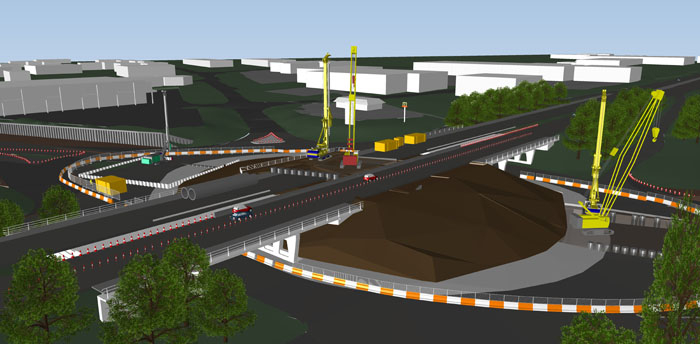BIM Academy’s Peter Barker explains how 4D modelling helped deliver the complex A19/A1058 Coast Road junction upgrade project and explores future trends we can expect to see in highways design
The A19/A1058 Coast Road junc tion is one of the busiest road intersections in the North East of England. In 2016, work start- – ed on a major upgrade to combat congestion and improve consistency in journey time. The £75m improvement project was a part of the UK Government’s £15 billion roads investment programme, which aimed to foster economic growth in the North East as part of the Northern Powerhouse initiative.
The challenging project required the installation of a three-level flyover / underpass and roundabout. To help plan construction and support the critical need to maintain traffic flow throughout, while minimising disruption, it was one of the first major highways infrastructure projects in the UK to utilise 4D BIM.
Construction in a live environment
In 2017, BIM Academy was approached by the JV supporting Highways England to work on the project. This was initially as a digital construction expert to assist in achieving compliance with the UK Government’s mandate for BIM Level 2, but the role quickly expanded to focus on delivering greater practical value throughout the two-year project and helped to bring the project in 31 weeks ahead of schedule.
Design team WSP and construction JV partners Sisk/Lagan worked with BIM Academy on this incredibly complex project. The size and scale of the upgrade were of course a factor, but the real challenge lay in the fact that the junction is a major regional component of the Strategic Roads Network (SRN) – and had to remain active throughout the course of construction. Working in a busy, and potentially hazardous live environment involved heavy restrictions and constraints on the construction process, posing significant challenges to the timescale and budget of the project – and perhaps most importantly, the safety and logistics considerations of improving road user experience with minimal disruption to transport routes.
An innovative solution was required to enable the project team to meet the safety requirements of a live environment, while still delivering a high-quality end result. As well as tackling appropriate standards and protocols, providing guidance to design and construction teams, BIM Academy brought forward a proposal to use 4D technologies on the project.
Introducing 4D
The idea was to link programme planning tools to the existing 3D digital design and terrain models, in order to more clearly visualise and communicate the construction sequence and potential barriers. Reviewing and assessing the potential construction sequences in a virtual environment became one of the project’s standard design steps before anything reached the live environment on site. Using programmes such as Revit, AutoCAD Civil 3D and Synchro, the team was able to visualise and analyse how construction sequencing would affect the live environment at any given time, by creating a visual dynamic sequence from the 3D model and planning software.
Not only did this approach aid in the planning coordination and buildability, it also significantly improved design of temporary works, which reduced the risk and negative impact of the project as well as streamlining and optimising the end solution, which incorporated smart traffic monitoring systems (STMS) and automated signalling, in a nod to future highways technologies.
The end result of the approach was that the project team was able to visually communicate and plan activities in the context of time and space, taking account of resources, procurement and spatial constraints. This created the thinking space – and provided the data – to assess alternative approaches to site layout, scheduling and logistics during the construction phase, providing a number of alternative options for contractors to assess all risks and opportunities, and make fully informed decisions around construction costs and sequencing.
This innovative approach to ‘optioneering’, as well as access to new and better data, was influential in the logistical improvement of the A19/A1058 Coastal Road project – so much so that 14 months were cut from the original estimated 42 month construction programme, saving over a year of road disruption and a huge amount of cost.
The future of highways design
This of course raises the question – should this approach be applied to all major highways improvements moving forward?
This optioneering process allowed the contractor to assess all risks and opportunities. The future of highway design is certainly focused on leveraging digital tools to assess and optimise alternative solutions whilst factoring in legislative design standards.
There are also other future trends we can expect to see in highways design. Systems such as Motorway Incident Detection and Automation Signaling (MIDAS) are being developed and implemented by Highways England right now, as a distributed network of traffic sensors.
Radar technology and magneto-resistive wireless sensors are also being trialed and are designed to alert local regional control centres (RCC) of traffic flow and average speed, as well as automating variable message signaling and advisory speed limits with minimal human intervention.
Improving traffic flow with the use of digital technology is something BIM Academy definitely sees being introduced in more and more projects such as this one, introducing the ability to proactively predict and control traffic with all of the consequent benefits on safety, environmental impact and user experience.
Highway design based purely on design of the physical infrastructure can be risky. Introducing a combination of sensors and 4D modelling is the way forward in smart infrastructure design, helping to measure the impact before it happens, and allowing for a smoother, less invasive, greener – and cheaper – project.
In the future, I believe we will start to see trends including the increased adoption of in-vehicle technology. The consequent reduction of roadside tech will follow, seeing the introduction of so-called ‘Naked Roads.’ We expect to see this concept escalating over the next two years as the government presses ahead with initiatives promoting vehicle-centric intelligent technologies.
If you enjoyed this article, subscribe to our email newsletter or print / PDF magazine for FREE







